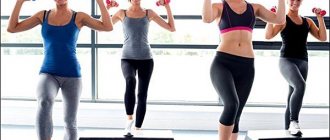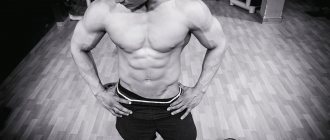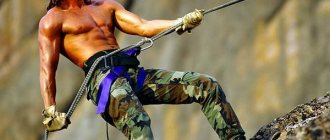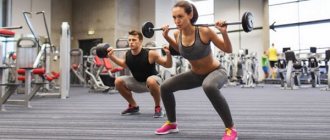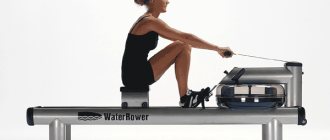In 2021, fitness clubs offer about 200 areas and training programs. Each lesson solves both individual problems and a complex of problems, including weight loss, strengthening the cardiovascular system, working out muscles, increasing joint mobility, developing endurance and generally improving health.
Despite the fact that fitness is not a professional sport, it is difficult for a person who knows little about physical activity to understand the intricacies of programs and exercise sets. But it will be easier to decide on the direction if you familiarize yourself in detail with the existing types of fitness. A wise choice will allow you to achieve the desired results, be it health, a slim figure, state of mind or emotions.
What types of training are there in fitness?
All types of fitness training are aimed at specific goals (stretching, building muscle mass, losing weight or strengthening the heart), include different types of loads (strength, aerobic, combined) and involve specific body systems.
Fitness programs with similar characteristics are conventionally grouped into areas. In particular, these are oriental practices, dance classes, strength or cardio training, mixed techniques and complexes more focused on stretching. To choose a suitable program for physical activity, it is better to get to know each type in more detail.
Eastern practices
The goal of training combined in this direction is the harmonious development and improvement of not only the body, but also the spirit. The techniques are usually based on smooth movements and static poses. Exercises work to develop coordination and balance, improve flexibility and agility, and increase muscle tone. The program also includes meditative and breathing practices.
During training, it is important to concentrate on the process and control the sensations in the body with your mind, since “wandering” thoughts will only interfere with achieving your goals. The result of such exercises will be not only a toned figure, elastic muscles, ligaments and a resilient body, but also improved emotional and mental health, and improved mood.
Yoga
One of the most popular styles of modern fitness, which has many subtypes, schools and trends. Based on traditional ancient Indian practices. Regardless of the direction, training is a set of physical and spiritual techniques aimed at the comprehensive development of the body. During the class, static poses are slowly performed in which you need to stay for some time. Particular attention is paid to proper breathing.
Asanas relieve pain in the spine and joints, tone the muscles of the whole body and generally have a beneficial effect on all systems of the body. Classes improve your psycho-emotional state and effectively combat stress, depression and insomnia. Yoga is accessible to people with any level of physical development and is especially suitable for those who are not ready for intense exercise and active sports movements. You can practice asanas at any age and at any weight.
Taiji (taichi)
The style is based on martial art (a type of wushu), invented by Chinese monks who observed the behavior of animals. As a result, the technique provides for measured, gradual, smooth techniques and gestures that slowly flow into each other. The practice involves proper breathing, proper mental attitude and concentration. They, like yoga, are aimed at simultaneous physical and spiritual development.
During classes, weights and additional equipment are often used, but this does not prevent us from recommending the equipment to older people and those who have no physical training at all. Such gymnastics restores joint mobility, strengthens the heart and blood vessels, improves blood circulation and teaches you to maintain mental balance. Tai Chi exercises relieve muscle and nervous tension, improve the mind and give restful sleep.
Pilates
Developed on the basis of tai chi and yoga, the Pilates system includes small amplitude dynamic movements aimed at working out (stretching and strengthening) every muscle of the body. It also provides for a clear interaction of exercises with the brain, but unlike some eastern practices, there is no static nature and “yogic” breathing in this direction. Regularly performing slow techniques makes muscles strong, straightens posture and helps with weight loss.
Fans of Pilates claim that this type of fitness can be done both in the gym and at home. And at any age and without a high level of physical fitness. But experts in the field and experienced La Salute trainers warn that, despite the safety of Pilates, classes should be started under the supervision of an instructor. This will eliminate the possibility of injury and will maximize the development of ligament elasticity, joint flexibility, strength and endurance.
Qigong
The smooth, continuous movements of Chinese ancient gymnastics are not aimed at specific parts of the body and muscles, but affect the entire body. The process of performing exercises requires concentration of thoughts and synchronization with breathing. Moreover, the latter in this technique can be different: hard, soft, abdominal and natural. The classes have a minimum of contraindications and are accessible to everyone in terms of difficulty level. But it is better to practice qigong with a certified master.
Kalaripayattu
The classes are based on Indian martial art, and the purpose of the training is physical and spiritual self-improvement. Self-defense techniques are diluted with gymnastic relaxation exercises and breathing practices. Kalaripayattu adherents promise that as a result of practicing:
- immunity will increase;
- your well-being will improve;
- stress levels will decrease;
- the figure will tighten;
- flexibility will develop;
- Laziness and apathy will disappear.
Budokon
A relatively new training program that has gained popularity among Hollywood stars and is actively promoted by the fitness industry. The classes combine various martial arts techniques, yoga asanas, breathing practices and meditation in a harmonious proportion. Training allows you to achieve excellent physical shape, develop self-knowledge and give peace of mind.
Dance group training
Such activities are often preferred by those who are bored with monotonous sports movements. The techniques are combinations of choreographic elements and basic steps that are performed to dynamic music. Training develops plasticity, increases flexibility, improves joint mobility and strengthens the heart muscle. In addition, dance fitness exercises actively burn calories, which as a result contributes to effective and fairly rapid weight loss.
Dance aerobics
The goal of such training is to strengthen muscle groups throughout the body, lose weight and relieve stress. The classes use various styles, such as hip-hop, funk, oriental and many others. Moreover, some dance programs have already been transformed into a separate form with their own varieties. For example, Zumba, whose workouts are accompanied by fiery Latin music and include movements of popular dances such as samba, mambo, flamenco and salsa.
Baylotherapy
This technique combines Latin and African dances, aerobic elements, Pilates, yoga and meditation. Accordingly, classes provide high performance and multidirectional effects on the body. In particular, this includes losing weight, developing muscles and strengthening the spine.
Strip plastic, cardio strip and half dance
Movements in such practices train plasticity, flexibility and femininity, as well as improve posture and promote weight loss. There are dynamic exercises, stretching, ballet choreography, and Latin. But all movements have a sexual connotation and are filled with non-vulgar and non-vulgar eroticism, which helps the fair sex to relax and begin to feel much more confident.
Pole Dance
Another technique with an erotic slant, but performed on a pole (pole). The movements are dominated by sports acrobatics and choreography. All elements are performed slowly, smoothly and require significant strength. Classes form a beautiful muscle profile, pump up the whole body and develop endurance. The exercises are suitable for both women and men.
Cardio training
This type of physical activity is widely represented in fitness. Such exercises are characterized by high duration, high number of repetitions and provide good results in burning fat and improving heart function. Many types use additional equipment: fitball balls, step pads or barefoot hemispheres.
Shaping
This type of load is nothing more than rhythmic gymnastics with a clear sequence of exercises. The workouts provide different levels of programs designed based on scientific evidence for nine body types. Shaping is aimed at women from 30 to 50 years old and is aimed at reducing weight and volume, building a toned figure and generally strengthening the muscles of the body.
Aerobics
An aerobics class is a classic cardio workout: simple gymnastics exercises are performed to rhythmic music that allows you to control the frequency of movements. Such fitness programs usually consist of leg swings, running in place, jumping, stretching, and push-ups, which tone muscles, strengthen blood vessels and promote weight loss.
Step aerobics
The essence of this technique is to perform sequences of steps using a special platform. Simple movements imitate going up and down stairs, accompanied by rhythmic music. A fairly intense workout perfectly tightens the muscles of the legs and buttocks, improves the figure and strengthens the ligaments and joints. Exercise prevents diseases of the musculoskeletal system and promotes recovery from injuries.
Cycle
Cycle is an intense workout on a special exercise bike, performed alternately while sitting in the saddle or standing on the pedals. In the process, the student imitates the passage of a real route over rough terrain, for which the trainer periodically changes the level of load. The training program is quite energetic, so it has some contraindications. But for those for whom such loads are acceptable, cycling helps to lose weight, strengthen muscles and generally bring the body into optimal physical condition.
Fitball and bosu
Aerobic exercises are performed in the first case on balls, and in the second - on a hemisphere, where they do ligaments similar to step steps. Training can be considered both as a separate type of fitness and as an addition to other programs. Exercises using such equipment develop muscles, increase endurance, flexibility and improve coordination of movements.
Water aerobics
This type of activity is suitable for people with numerous health problems: scoliosis, thrombosis, hernias, varicose veins and other pathologies. When performing exercises, water relieves stress from the spine and joints, helping the body effectively pump muscles, strengthen the heart, develop lungs and lose weight. It’s also great that you don’t have to know how to swim to attend these classes: most of the movements are done simply while standing in the water. Exercises in the pool are suitable for people of any age, body type, and level of physical fitness.
Power training
Strength training uses weights, machines and your own weight, which helps build muscle mass and increase endurance. Exercises in these styles of fitness loads are performed with a small number of repetitions, but with high intensity.
Tai-bo
Although the name of this type of fitness comes from the word “taekwondo,” the workouts are more like aerobics mixed with Muay Thai. Quite dynamic exercises are performed to rhythmic music and combine arm movements reminiscent of boxing punches, dance steps, jumps and swings. Some tasks require the use of weights. Such exercises deeply work the muscles of the legs, arms and abs, improve flexibility and reduce body fat.
Crossfit
CrossFit workouts are intense interval techniques that include elements of weightlifting, gymnastics, running, weight lifting, powerlifting, rowing and others. In this case, static and strength exercises are combined, any of which usually lasts 20 minutes. Programs allow you to increase endurance and create a beautiful, strong body. However, experts say there is a high risk of injury, so training on your own is not recommended.
Body Sculpt
Any session using the Body Sculpt technique takes place in an aerobic mode, lasts 50 minutes and uses dumbbells, body bars and shock absorbers throughout. Such training is aimed at developing strong muscles and creating a beautiful body contour. At the same time, the type of fitness is considered accessible even to beginners, since the weight used can vary, and the maximum weight reaches only 6 kg.
Bodypump
In this style, as in Body Sculpt, equipment is also used - a barbell that is suitable for the weight of a specific user. Moreover, during the exercise, each muscle is selected with its own weight. The group training itself takes place non-stop, and the complex includes different types of exercises that involve all muscle groups and are repeated several times. Working in this mode is classified as strength aerobic exercise, which not only strengthens muscles, but also helps reduce volume by burning subcutaneous fat.
Fitness for stretching
Stretching activities reduce tension in the muscles and improve their blood supply, develop joint mobility and reduce the risk of age-related changes. Exercise is considered an excellent prevention of stress-related injuries and a good way to relieve muscle spasms and pain. Stretching exercises improve the elasticity of ligaments, straighten posture and gait, and also have a positive effect on vascular health and relieve mental stress.
Stretching
The stretching program involves classic stretching of tendons and muscles. The exercise system increases the flexibility of the spine and the elasticity of the ligaments, and also allows you to improve motor activity even in adulthood. The main advantage of the complex is that it does not overload the heart, and stretching can be done even with diseases of the organ. There are several methods and types of stretching:
- Static. When performing the exercise at the peak of extension, a delay in the pose is made for 0.5-3 minutes.
- Dynamic. The complex consists of springing movements and combinations of exercises of varying speeds, during which the emphasis is placed on the moments of maximum extension.
- Passive. Training does not involve working independently, but with the help of pressure from a partner.
- Isolated. Perform stretching exercises only for a specific muscle.
- Isometric. In this stretching, relaxation and stretching alternate.
Stretching exercises are used not only as an independent type of fitness, but also as part of other training programs.
Callanetics
The callanetics health complex is based on simple static exercises from ballet and yoga, as well as some breathing practices. A training complex of 29 elements helps speed up metabolism, and at the same time engages all the muscles of the body (deep and inactive ones as well). At the same time, the effectiveness of 1 hour of callanetics training is compared with 7 hours of shaping training. The exercises form correct posture, a beautiful muscular corset and have no contraindications for diseases of the spine. The system is suitable for everyone.
Bodyflex
The author's technique involves performing stretching exercises on various muscle groups with simultaneous breathing techniques for holding inhalation. Such training saturates cells with oxygen, normalizes blood supply to tissues and increases metabolism. The processes help strengthen muscles, lose weight and work to tighten the skin. Physiologists are still debating the effectiveness of bodyflex in weight loss, but the benefits of the program as a whole are beyond doubt.
Mixed group cardio and strength training
Mixed fitness training intelligently combines aerobic and strength training. This simultaneously leads to strengthening of the heart and muscles, the formation of a sculpted body and a decrease in volume. Typically, such classes are carried out at a high pace with quick changes of exercises, so they are not always suitable for physically unprepared users.
Circuit Training
The name of the program translates as “circular training” and this fully conveys the essence of the lesson, during which cycles of exercises included in the circle are repeated. At the same time, cardio and strength training are alternated. In addition, each movement is performed for a certain time or number of times, and the complete passage of the designated part is completed with rest. The set and number of tasks are developed by the coach, taking into account the level of training of the group participants. But usually this is running in place, jumping, squats, push-ups, abs, crunches and plank variations.
Interval/HIIT
The principle of interval training is the alternation of cardio tasks and strength exercises of varying intensity, for which certain periods of time are allocated. Such techniques do not so much increase muscle mass as activate metabolism and allow you to quickly burn calories and subcutaneous fat. The lesson lasts only 30 minutes, but the exercises are performed almost without interruption. For example, 20 seconds of high-intensity technique alternate with 60 seconds of a calm pace, and this is repeated for half an hour. The technique is suitable for people with training.
Interesting! An example of a high-intensity HIIT workout is the Tabata technique. This lesson lasts only 4 minutes and is carried out strictly using a stopwatch. During the specified time, repeat the following cycle 8 times: 20 seconds of intense exercise and with maximum impact (running, jumping, push-ups, squats, lunges, pull-ups, etc.), and then 10 seconds of rest. Tabata is ideal for muscle growth and weight loss.
FT/Functional Training
The peculiarity and advantage of such classes is the ability to work out all muscle groups, including small, deep and stabilizer muscles. To do this, complex, from a biomechanical point of view, exercises are used, and for greater efficiency, sports equipment is used. Such trainings promote weight loss, strengthen muscles and form correct posture.
TRX
Intensive classes are carried out using hanging loops, when work is carried out with your own body weight. This unique exercise machine is equipped with inserts for arms/legs and is attached to the ceiling. With its help, strength, functional, aerobic and static exercises are performed, which allows you to comprehensively strengthen the body. Moreover, ordinary movements give maximum results due to the need to balance and maintain balance. Training brings the body into ideal condition and increases the body's endurance.
Important! This division is quite arbitrary, because some types of fitness have features of several directions. For example, strength exercises include stretching, and dance movements are often used as a warm-up. It is for this reason that different classifications can be seen in different sources. Examples of this are stretching, callanetics, crossfit, pilates and many others.
Types of physical exercises.
Most of us understand that in order to be healthy we need to exercise. But, unfortunately, not everyone knows what exercises there are and what they are needed for. Below are the main types of physical exercises and their descriptions.
Strength exercises. Strength exercises are aimed at training and strengthening muscles, and, accordingly, at the formation of muscle relief in men. Women tend to use strength training to burn fat and strengthen specific muscle groups. Strength exercises include exercises with a barbell or dumbbells. This also includes working on machines or with your own weight. It is most effective to exercise with a barbell, since with it you can perform such exercises as squats with a barbell on the back, deadlifts, barbell presses on benches with different inclination angles, barbell rows in an inclined position or to the chin. It is even more effective, but also much more difficult, to perform exercises with dumbbells, since with their help not only the main muscle groups are involved in the work, but also the stabilizer muscles. Consequently, we use one more type of muscle fiber, in addition to the main ones, which means we train more muscles in general. But often people are poorly prepared for training with free weights. In this case, they can be recommended to exercise on machines or with their own weight (for example, doing pull-ups on a horizontal bar or doing push-ups on parallel bars). There are times when a person cannot even do pull-ups. Then he can be helped by a simulator such as a vertical block, on which he can perform rows to the chest. If you train your whole body in one workout, then the frequency of training should not be more than 1-2 times a week. If in your training you use division (split) into several muscle groups, then you can train 3-4 times a week.
Aerobic exercise. The next type of load is lighter. Thanks to aerobics, we train the heart, breathing and endurance. Everyone can choose for themselves what they like best. Some will prefer running (in the park, at the stadium, in the forest), others will prefer swimming (in a pool or some body of water) or dancing (fast or slow dancing with a girl at a disco). You can also do aerobics in a gym with people in groups. If you have friends, you can team up and play various sports games - football, volleyball, basketball, handball or tennis. In aerobic training, such as running, it is important to consider its duration so as not to overtrain. When running, you need to start gradually. Start by running for 5 minutes. Then, increasing the duration by 1 minute every day, bring it to 15-30 minutes. You can do running at least every day, and not 1-2 times a week, like strength exercises. It's best to do this outdoors.
Stretching exercises. The third type of exercise is stretching. It is the easiest when compared with strength and aerobic exercises, but it should also not be forgotten. Stretching can also be divided into 2 types: dynamic and static. Dynamic stretching should be performed before aerobic or anaerobic exercise, such as doing circular movements with your arms in different directions to warm up the muscles of the chest, shoulders and arms. Or perform a series of 20-30 light squats or forward bends with a pause at the bottom to stretch the muscles of the legs and back. Dynamic stretching can be used as a warm-up before your main strength training session. She should spend about 10 minutes. As for static stretching, it should be performed after strength or aerobic training. It includes the following exercises: hanging on the horizontal bar (stretching the back, biceps, rear deltoids), lock (stretching the chest, triceps, front deltoids), squatting (stretching the hips, buttocks, lower back), bridge (stretching the abdominals, as well as chest). These are basic exercises that stretch the largest muscle groups (chest, back, legs). Also, if you wish, you can add something of your own to, for example, stretch your calves, forearms or biceps. But these are small muscle groups and stretching them can be done less frequently. The basic rule of static stretching is the following: you need to hold a pose for 1 minute. If you are fanatical, you can eventually increase the duration to 3-5 minutes, but no more.
Thus, by performing all 3 types of physical exercise, you will be in very good physical shape, feel good and look great. And the biggest advantage is that you will become the owner of excellent health. And don’t forget that a healthy lifestyle is not only physical activity, but also proper nutrition, healthy sleep, hardening and other components.
HAVE FUN AND BE HEALTHY!
New types of fitness
Those who prefer variety in sports, want to change the load, want to try a new direction or simply “be on trend” can consider the types of fitness training that have appeared relatively recently. Some of them have already been described above, in particular, Budokon, Bosu, dance aerobics, tai-bo, baylotherapy and TRX. Other popular types are presented below:
- Jumping fitness. The author's training program, which appeared only 20 years ago, can not be taken seriously. After all, the lesson is identical to the fun of children and teenagers - trampoline jumping. Nevertheless, such a workout is an excellent cardio exercise and allows you to effectively lose weight, tighten your body contours and tone your muscles.
The mini trampoline is equipped with a handle to maintain stability while jumping. The activity itself involves performing movements in “flight”, when the legs push off the surface. This activity is suitable for people of any gender, age and body type. Simple workouts will lift your spirits, work your muscles and improve your coordination.
- Kangoo jumps. Like the previous type of fitness, kangaroo training involves jumping. The class takes place in special shoes equipped with springs, which were invented by an orthopedic doctor about 50 years ago. But fitness programs using boots have appeared relatively recently, so the style is considered quite new. Now there are at least 5 directions: power, dance, boot camp, kick&punch and for children over 6 years old. Most of them develop strength and endurance, work the muscles of the legs, abs and buttocks with an extremely low load on the joints and spine. Also, with the help of kangaroo jumping, you can burn up to 1000 kcal in 1 hour of exercise.
- Terarobics. The program appeared a quarter of a century ago, but has only received development in the last 3 years. The classes are classified as recreational aerobics, but the complex includes stretching, dancing and strength gymnastics. Cardio training is carried out at a high pace, and shock absorbers (latex or rubber band with clamps for the limbs) are used as an additional load.
The complexity of the exercises and choreographic content of teraborics is accessible to all ages, and the level of load is adjusted individually using the length of the shock absorbers. Classes help you lose excess weight, train the strength of your arms and legs, give you vigor and improve your psycho-emotional state.
- Ki-bo. The technique is similar to the previously described type called “tai-bo”. But ki-bo does not use aerobic exercises, but elements of dance. Thus, this type of fitness is a combination of martial arts and choreography. This activity burns up to 800 kcal, which promotes rapid weight loss. Ki-bo training is a kind of shadow boxing. The movements of the arms and legs resemble blows that are carried out against an invisible enemy. The training program develops strength, flexibility, strengthens the heart and respiratory system, and works the muscles of the whole body. In addition, punching the air relieves negative emotions, stress and depression.
- Aerofitness. Such training is now at the peak of popularity. Here, exercises from yoga, callanetics and Pilates are performed in a suspended state, using bands or a hammock. Fitness training uses up to 90% of the body's muscles, stretches the spine, relieves stress on the joints and ensures blood flow to the brain. You can benefit and enjoy yoga in hammocks at the La Salute club. Training under the supervision of experienced instructors, competent individual programs, convenient schedule and comfortable conditions - all this will ensure safety and maximum effect from physical activity in the air. Regardless of age and weight.
- Body ballet. This type of fitness appeared about 15 years ago and is a lightweight version (without complex choreography) of classical ballet. The training program is supplemented with elements of aerobics, Pilates and yoga, and movements are performed mainly at the machine. Training takes place at a moderate pace, often accompanied by classical music. The exercises are aimed at strengthening and stretching the muscles of the buttocks and legs, creating a beautiful figure, improving posture and relieving stress. The technique eliminates pain and the possibility of injury. The program is ideal for those who are contraindicated for intense exercise, but want to improve their physical condition and correct their body shape.
- Rope skipping. The sport, known since ancient times, became a fitness trend relatively recently (in Russia about 10 years ago). The training involves performing tricks of varying complexity when jumping over a skipping rope or rope and includes elements of acrobatics and dance choreography (breaking, hip-hop, rock and roll and others).
Such a dynamic activity is not just intense cardio exercise, but also high-quality strength work. The movements involve almost all the muscles of the body and actively burn subcutaneous fat. In addition, learning dance routines trains memory, and jumping rope develops dexterity and teaches coordination.
Important! During high-intensity exercise, it is necessary to continuously monitor your heart rate. To do this, it is better to wear a special device on your wrist during class. It will notify you that your heart rate has exceeded the maximum permissible values.
Methodological manual for trainers and teachers of additional education in the field of physical education and sports
Compiled by: Semenyuta T.N., Deputy Director of the MBUDO Youth Sports School for Methodological Work
BASICS OF SPORTS TRAINING
Sports training is a planned pedagogical process that includes teaching an athlete sports techniques and tactics, developing his physical abilities.
The purpose of sports training is preparation for sports competitions, aimed at achieving the highest possible level of preparedness for a given athlete.
Objectives of sports training:
— mastering the technique and tactics of the chosen sports discipline;
— improving motor qualities and increasing the capabilities of the body’s functional systems, ensuring the successful completion of a competitive exercise and achieving the planned result;
— education of the necessary moral and volitional qualities;
— ensuring the necessary level of special mental training;
— acquisition of theoretical knowledge and practical experience necessary for successful training and competitive activities.
All tasks are solved comprehensively and aimed at achieving the highest sports performance.
The results of solving sports training problems are expressed by the concepts of “fitness,” “preparedness,” and “sports form.”
Fitness is the degree of functional adaptation of the body to the proposed training loads, resulting from systematic physical exercise, which helps to improve a person’s performance, and is always focused on a specific sport.
Fitness is divided into general (increasing the functional capabilities of the body through general developmental, health-promoting exercises) and special (specific sport).
Preparedness is a complex result of physical, technical, tactical, and mental preparation. Each of the aspects of preparedness depends on the degree of perfection of its other aspects, is determined by them and, in turn, affects their level.
Sports uniform is the highest degree of preparedness of an athlete. It is characterized by its ability to simultaneously implement various aspects of preparedness in competitive activity.
Sports training aids
The main means of sports training are a variety of physical exercises.
Classification of physical exercises:
- Based on historically established systems of physical education, the entire variety of physical exercises was accumulated into four typical groups: gymnastics, games, sports, tourism.
Each of these groups has its own characteristics, but mainly they differ in pedagogical capabilities. Specific purpose, as well as methodology.
- By anatomical basis: all physical exercises are grouped according to their effect on the muscles of the arms, legs, abdominals, back, etc.
Using this classification, various sets of warm-up exercises are compiled.
- Based on their primary focus on developing individual physical qualities:
- speed-strength exercises characterized by maximum effort power (short distance running, jumping, throwing, etc.);
— cyclic endurance exercises (middle and long distance running, swimming, cross-country skiing, etc.);
— exercises that require high coordination of movements (acrobatics, gymnastics, diving, figure skating, etc.);
- exercises that require complex manifestation of physical qualities and motor skills in changing modes of motor activity and situations (sports games, wrestling, boxing, fencing, etc.).
- Based on the biomechanical structure of movement, cyclic, acyclic and mixed exercises are distinguished.
- Based on physiological power zones, exercises of maximum, submaximal, high and moderate power are distinguished.
- Based on sports specialization, sports training means are divided into three groups:
- general training; specially preparatory and selectively competitive.
General preparatory - are primarily means of general training of athletes, effectively solving the problems of comprehensive physical development. Insufficient growth in results or even cessation of their growth, as well as increased injury to the athlete, is due to an insufficient amount of general preparatory exercises, especially in the early stages of training.
It must be remembered that general preparatory exercises must express the specifics of the chosen sport.
Specially preparatory - determined by the specifics of the chosen sport. Exercises are selected in such a way as to provide a more targeted and differentiated effect on improving physical abilities and developing the skills necessary for the athlete.
Special preparatory exercises are divided into introductory and developmental.
Leading – contribute to the development of form and movement techniques.
Developmental – aimed at developing and improving basic physical qualities (strength, speed, agility).
Selected competitive exercises are integral motor actions or a set of motor actions that are a means of wrestling and are performed, if possible, in accordance with the rules of competition in the chosen sport.
Sports training methods
A sports training method is a method of using basic training means, a set of techniques and rules for the activities of an athlete and a coach.
Two large groups of methods are used in the training process:
1. General pedagogical, including verbal and visual methods;
2. Practical, including the method of strictly regulated exercises, game and competitive methods.
- General pedagogical methods
Verbal methods : story, conversation, analysis, discussion, etc.
The effectiveness of the training process largely depends on knowledge of terminology, skillful use of instructions, comments, verbal assessments and explanations.
Visual methods:
— correct methodological demonstration by an athlete or coach;
— demonstration of videos, films, diagrams, etc.;
- the use of simple landmarks that limit the direction of movement and the distance covered;
- use of light, sound and mechanical leading devices.
- Practical methods
Strictly regulated exercise methods:
— methods aimed at mastering the technique of performing the exercise;
- methods aimed at developing physical qualities.
- Among the methods aimed primarily at mastering sports techniques, the following methods are distinguished:
— holistic-constructive (learning simple exercises as a whole)
— dismembered-constructive (learning more complex exercises in parts).
When applying the above methods, great importance is given to leading and imitation exercises.
- Methods aimed at developing and improving physical qualities are divided into interval and continuous.
Continuous methods – one-time continuous execution of training work.
Interval methods - performing exercises with both regulated pauses and involuntary rest pauses.
When using these methods, exercises are performed in a uniform and variable mode.
With a uniform mode, the intensity of work is constant, with a variable mode it varies.
The intensity of work from exercise to exercise may increase or change repeatedly.
In continuous and interval operation modes, the circular method (stationary) can be used, aimed at selective or comprehensive improvement of physical qualities.
The game method is used not only for initial training in movements or influencing individual abilities, but also for the comprehensive improvement of motor activity in complex conditions.
To the greatest extent, it allows you to improve such qualities as dexterity, resourcefulness, quickness of orientation, independence, and initiative.
It serves as a very effective method of instilling collectivism, camaraderie, conscious discipline and other moral qualities of the individual.
Methods (ways) of organizing the activities of those involved
- Frontal method - performing the same task by the entire group, regardless of the formation of students (column, line, circle). When using the frontal method, a high density of training sessions is ensured. It is important that with the frontal method, students do not interfere with each other and everyone sees the trainer-teacher, and he sees all the students.
- Group method - simultaneous completion of different teacher tasks in several groups. The division into groups is carried out according to the level of training and other characteristics (weight and height indicator).
This method requires special training of teaching assistants from among the most prepared students and their advance instruction on the task to be performed.
- Individual method - as a rule, is intended for students who differ in preparedness from the main group.
Principles of Sports Training
The principles of sports training are the most important pedagogical rules for the rational construction of the training process, which systematizes scientific data and advanced practical experience in coaching.
The principle of focusing on the maximum possible achievements, in-depth specialization and individualization.
Setting for the highest performance is achieved by appropriately constructing sports training, using the most effective means and methods, and in-depth specialization in the chosen sport.
The focus on the maximum determines all the distinctive features of sports training - an increased level of loads, a special system of alternating loads and rest, pronounced cyclicity, etc.
Sports specialization is characterized by the most favorable distribution of time and effort in the process of improving sports activity in a chosen sport, but is not the same for other sports.
In this regard, it is extremely important to take into account the individual characteristics of those involved when building sports training.
An erroneous choice of specialization or a certain role in a team that does not meet the individual qualities of an athlete often negates the efforts of the athlete and coach.
The principle of individualization requires the construction and conduct of training taking into account the age characteristics of the athlete and his level of preparedness.
The principle of unity of general and special training.
Objective laws of sports improvement require sports training. Being a deeply specialized process, it would at the same time lead to comprehensive development. In accordance with this, sports training inextricably combines general and special training.
The unity of general and special training means that it is impossible to exclude any aspect of training from the training process without compromising the growth of sportsmanship.
The unity of general and special training is interdependent at each stage of sports training on the type of sport and on the stage of training.
The optimal ratio of general and special training naturally changes at different stages of sports improvement.
The principle of continuity of the training process is characterized by the following basic provisions:
— sports training is built as a year-round and long-term process that guarantees the greatest cumulative (cumulative) effect in the direction of sports specialization;
— the impact of each subsequent training session, as it were, “layers” on the “traces” of the previous one, consolidating and deepening them;
- the rest interval between classes is maintained within limits that guarantee restoration and increase in performance, and within the framework of training meso- and microcycles, under certain conditions, it is allowed to conduct classes against the background of partial under-recovery, due to which a denser regime of loads and rest is created.
It is necessary to structure the training process in such a way as to ensure, to the greatest extent possible under given specific conditions, the continuity of the positive effect of training sessions, eliminate unjustified breaks and minimize training regression. This is the main essence of the principle of continuity of sports training.
The fundamental methodological meaning of this provision lies in the requirement to avoid excessively long intervals between training sessions, to ensure continuity between them and thereby create conditions for progressive achievements.
The principle of the unity of gradualism and extremeness in increasing training loads . The increase in the functional capabilities of the body naturally depends on the training and competitive loads imposed. A gradual and maximum increase in training and competitive loads determines the progress of sports achievements.
This is ensured by increasing the volume and intensity of training loads, and gradually increasing the complexity of the requirements for the training of an athlete.
Graduality in training should correspond to the capabilities and level of preparedness of the athlete, especially the young one, ensuring a steady increase in his sporting achievements.
The principle of wave-like load dynamics.
A progressive increase in training loads at certain stages of preparation conflicts with the course of adaptive changes in the athlete’s body. This makes it necessary, along with rest, to temporarily reduce the load, ensuring the necessary biological changes in the athlete’s body. Therefore, the dynamics of training loads cannot look like a straight line - it takes on a wave-like character.
Wave-like changes in load are characteristic both for relatively short periods of the training process and for stages and periods of the annual training cycle.
Wave-like fluctuations are characteristic of both the dynamics of volume and the dynamics of load intensity, and their maximum values in most cases do not coincide.
The principle of cyclical training process.
It is characterized by partial repeatability of exercises, classes, stages and entire periods within certain cycles.
Each next cycle is a partial repetition of the previous one and at the same time expresses the development trends of the training process, i.e. differs from the previous one in updated content, partial changes in the composition of means and methods, increased training loads, etc.
The effectiveness of the training process depends critically on the rational combination of repetitive and dynamic moments when constructing training.
The entire training process, from its elementary links to the stages of long-term training, consists of cycles (micro-, meso-, macrocycles) that make up an integral system of rational construction of the training process.
The principle of unity and interrelation between the structure of competitive activity and the structure of the athlete’s preparedness.
This principle reflects the structure, relationship and interdependence of an athlete’s competitive and training activities.
The rational construction of the training process presupposes a strict focus on the formation of an optimal structure of competitive activity, ensuring the effective implementation of competitive struggle.
This principle should be particularly guided when creating a training process management system and developing long-term planning for a relatively long period.
The principle of age adequacy of long-term sports activity.
In the process of long-term training, it is necessary to take into account the dynamics of the athlete’s age-related development, which makes it possible to effectively influence the age-related dynamics of abilities manifested in sports, in a direction leading to sports improvement and at the same time not conflicting with the laws of ontogenesis (individual development) of a person.
In childhood and adolescence, when the formation and maturation of the body occurs, the effect of training depends on taking into account especially sensitive periods, characterized by higher rates of development of abilities than in other periods.
In adolescence, until full maturity, general physical training should be fundamental in training, the formation in each athlete of the entire complex of physical abilities (strength, speed, endurance, etc.)
The main aspects of sports training
- Sports and technical training is the degree to which an athlete has mastered movement techniques in a chosen sport, aimed at achieving high athletic results.
One of the most important methodological conditions for improving technical skill is the relationship and interdependence of the structure of movements and the level of development of physical qualities.
Correspondence of the level of physical fitness of an athlete to the level of proficiency in his sports equipment is the most important provision of the methodology of technical training in sports.
Conventionally, a distinction is made between general technical and special sports and technical training.
The objectives of general technical training are to expand the fund of motor skills and abilities (school of movements), as well as to develop motor-coordinating abilities that contribute to technical improvement in the chosen sport.
Motor skill is the ability to perform a motor action based on certain knowledge about its technique.
Repeated repetition of motor actions leads to gradual automation of movements, and motor skill becomes a skill.
Skill is the degree of mastery of technology in which movement control is automated and actions are reliable.
- Sports-tactical training is a pedagogical process aimed at mastering rational forms of wrestling in the process of specific competitive activity.
It includes studying:
— general provisions of the tactics of the chosen sport;
— judging techniques and competition regulations;
— tactical experience of the strongest athletes or teams;
— mastering the skills to build your tactics in upcoming competitions;
— modeling the necessary conditions in training and control competitions for practical mastery of tactical formations.
Tactical training is inextricably linked with the use of a variety of technical techniques.
- Physical training is aimed at nurturing physical qualities and developing functional capabilities that create favorable conditions for improving all aspects of training. It is divided into general and special training.
General physical training (GPP) in modern sports training is associated not with versatile physical improvement in general, but with the level of development of qualities and abilities that have an indirect impact on sports achievements and the effectiveness of the training process in a particular sport.
General physical training means are physical exercises that have a general effect on the body and personality of the athlete (running, skiing, sports games, swimming, exercises with weights, etc.).
General physical training is carried out throughout the entire annual training cycle.
Special physical training (SPP) is characterized by the level of development of physical abilities, capabilities of organs and functional systems that directly determine achievements in the chosen sport.
The main means of SPT are competitive exercises and specially preparatory exercises.
Physical training is closely related to sports specialization.
- Mental training is a system of psychological and pedagogical influences used to form and improve athletes’ personality traits and mental qualities necessary for the successful implementation of training activities, preparation for competitions and reliable performance in them.
How to choose a direction for yourself
The existing variety of types and areas of fitness makes it easy to choose the appropriate activity. But before you make your final decision, you need to take into account several factors, the first of which is your health status. It is necessary to undergo an examination at a medical institution and consult with a doctor to take into account contraindications and eliminate the possibility of negative consequences for the body.
Further, it is advised to consider classes depending on your goals, for example:
- Swimming, treadmill running, exercise bike, bodyflex and oriental techniques will help support the heart, blood vessels and respiratory system;
- You can lose weight and achieve general strengthening of the body using programs with jumps and multidirectional steps;
- to create beautiful athletic figures and lose weight, you can choose aerobics, strength and mixed training;
- Cardio exercises combined with Pilates, as well as bodyflex, will help remove the belly;
- You can achieve weight loss in your lower extremities with interval training alternately with cardio or body ballet.
The choice of direction also depends on age:
- For girls and women aged 18–30 years old, options of varying complexity are suitable, since at this age you can cope with almost any load. To achieve effective results, it is recommended to alternate types of exercises: stretching, static and cycling.
- Women aged 30–40 years will benefit from strength training with equipment, water aerobics and yoga. These classes can be combined with exercises on simulators.
- After 40, they recommend, in particular, stretching fitness, cycling and oriental practices. But depending on the state of the body, options are possible (dance classes, fitball).
- In the postpartum period, low-impact training and dance programs should be considered, and strength and aerobic programs should be started only after 2 months of regular activity.
- Men can choose any physical exercise, alternating cardio with strength training. At the same time, split training is recommended for more advanced athletes, when certain days are allocated to work specific muscle groups.
And, of course, it is worth taking into account personal preferences and mood. For example, some people like monotonous, measured exercises, some will like active “explosive” workouts, and others will want to relax while performing oriental sets of exercises. When choosing, you need to pay attention even to the musical accompaniment.
Important! In different fitness clubs, the same directions do not always have the same content. Therefore, after studying the theory, it is important to communicate with the instructor, or better yet, attend a trial lesson. These measures will also allow you to select a program of the appropriate level of complexity.
